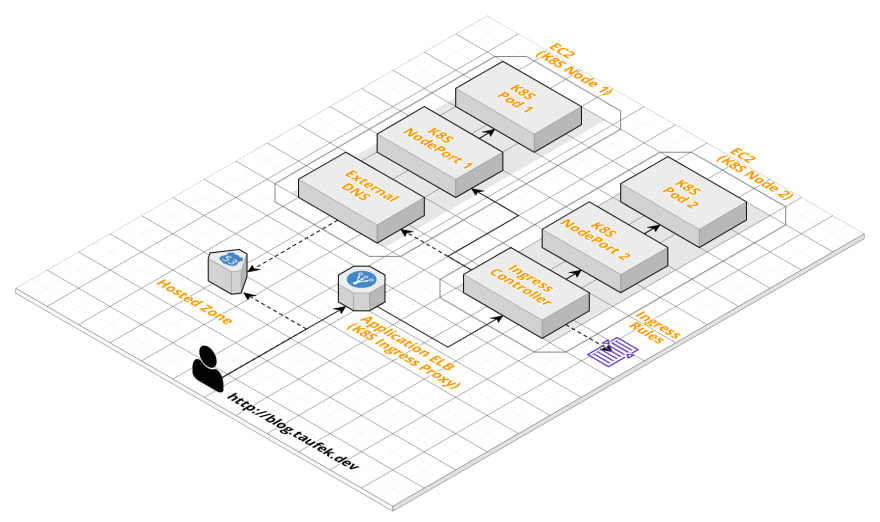Manage Applications with Ingress

Taufek Johar
Posted on June 9, 2020

Ingress is the gate keeper to your cluster. All external access will go through your Ingress Controller and depending on the rules that you set, it will be redirected to a particular service.
There are multiple benefits of having Ingress in my cluster.
- Replaced Classic ELB with Application ELB.
- Rules and External DNS.
- Redirect to HTTPS.
There are few implementations of Kubernetes Ingress we can choose from and the one I’m using is aws-alb-ingress-controller.
Replaced Classic ELB with Application ELB
Below is my previous setup before having Ingress.
When you visited this blog, the request goes through Kubernetes ‘LoadBalancer’ Service and it will be redirected to one of the Pod which will serve this lovely content 😛. For the purpose of this simple site, this is more than sufficient.
But I’m not going to stop here since the purpose of the whole thing is to learn and we will move forward with Ingress.
Below is my current setup with Ingress.
Now the previous Classic ELB has been replaced by Application ELB. ELB acts as an Ingress Proxy. It will be the single point of entry for all external access to my cluster. The Kubernetes ‘LoadBalancer’ Service is now replaced by Kubernetes ‘NodePort’ Services which are only accessible internally.
One benefit of having Application ELB over Classic ELB, the pricing is much cheaper 💰. Yeay!. And the goodness does not stop here.
Rules and External DNS
Ingress Rules contains the instructions that will help Ingress Controller to redirect the request to the correct services.
Below is an excerpt of my Ingress Rules. It says all request that matches the host and path,should go to a particular Kubernetes ‘NodePort’ Service.
apiVersion: extensions/v1beta1
kind: Ingress
metadata:
name: ingress
...
spec:
rules:
- host: blog.taufek.dev
http:
paths:
- path: /*
backend:
serviceName: blog-nodeport-service
servicePort: 80
Another cool thing about this is the External DNS which will automatically sync with Hosted Zone in AWS Route 56. If I need to add a new rule with new ‘host’, like below, this will trigger a task to update my Hosted Zone with new Record Set. Or if I remove a particular ‘host’ from the rules, it will also remove the Record Set.
spec:
rules:
- host: blog.taufek.dev
http:
paths:
- path: /*
backend:
serviceName: blog-nodeport-service
servicePort: 80
- host: api.taufek.dev
http:
paths:
- path: /*
backend:
serviceName: api-nodeport-service
servicePort: 8080
Redirect to HTTPS
Not all browsers like Chrome will auto redirect my *.dev domain to https. I would like to have consistent experience for all browsers so I will force all the request to HTTPS. This is easily achieved with Ingress Rules. Below is the configuration to implement HTTPS redirect.
apiVersion: extensions/v1beta1
kind: Ingress
metadata:
name: ingress
annotations:
kubernetes.io/ingress.class: alb
alb.ingress.kubernetes.io/certificate-arn: <ADD_YOUR_CERT_ARN_HERE>
alb.ingress.kubernetes.io/listen-ports: '[{"HTTP": 80}, {"HTTPS":443}]'
alb.ingress.kubernetes.io/actions.ssl-redirect: '{"Type": "redirect", "RedirectConfig": { "Protocol": "HTTPS", "Port": "443", "StatusCode": "HTTP_301"}}'
spec:
rules:
- host: blog.taufek.dev
http:
paths:
- path: /*
backend:
serviceName: ssl-redirect
servicePort: use-annotation
- path: /*
backend:
serviceName: blog-nodeport-service
servicePort: 80
Conclusions
With this change, not only it helps me to cut down my AWS bill, it also made the cluster to be easily managed. If I need to serve new application, I no longer need to spawn new LoadBalancer Service, configure the SSL cert and etc. I only need to do it once for the Application ELB that serves as Ingress Proxy. All new applications will be managed via Ingress Rules. Although it looks more complex on the diagram but it helps if you plan to have multiple applications in your cluster.

Posted on June 9, 2020
Join Our Newsletter. No Spam, Only the good stuff.
Sign up to receive the latest update from our blog.
Related
November 28, 2024
November 19, 2024
November 25, 2024


